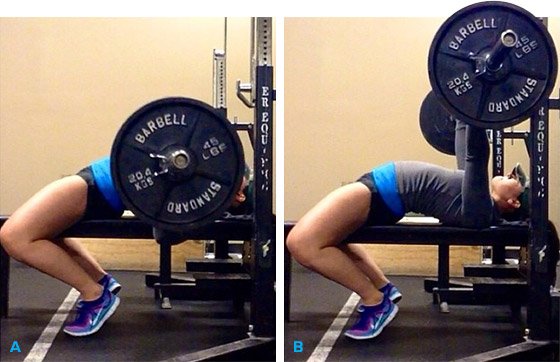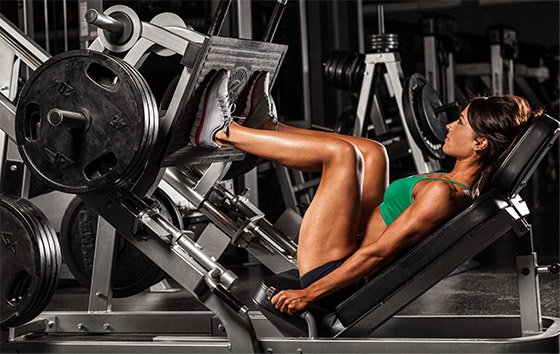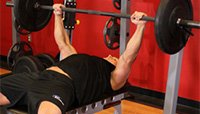Follow Us
When I first picked up weights a few years ago, maximal lifting wasn't even on my radar. I ran around in circles with my 10-pound dumbbells, completely unaware that I was missing out on an entire world of fitness.
In the world of 1RM strength, you set specific goals and work for weeks or months to inch closer to them. You push your body to its limits to achieve a triumph that only lasts a couple of seconds. But you also get rewarded with a rush unlike anything else. It's a great world to be a part of, and it's changed the entire way I view health and fitness.
I wouldn't say I'm an expert on heavy lifting—yet. But I've still learned some important lessons along the way, and I'm confident you'll find them just as helpful as I did. If you're looking to find your numbers or move them up into uncharted territory, here are five rules you need to take to heart.
Train Systematically
If you're currently training in the 10-20 rep range and have limited experience with anything less—think 3-8 difficult reps—then you aren't ready for a 1RM test. Attempting a max test when you're mentally and physically unprepared is a bad idea. You're just setting yourself up for failure.
I highly suggest using a program that trains specifically for the kind of intensity you'll find in a 1RM test. I used Jim Wendler's 5/3/1 system successfully for several months before getting a more personalized powerlifting training program from the Strength Guys. Trust me, proper programming makes all the difference both in terms of performance and safety. Squatting 3 reps at 85 percent 1RM is an entirely different ballgame than doing 15 reps on the leg press. Programs like 5/3/1, the Westside System, or Stronglifts 5x5 will prepare you for the intensity that lies ahead.
If you're unsure of your max or haven't yet had the chance to test it, I suggest using a 1RM calculator initially. Just enter your best lift, and it does the work for you. The heavier the weight and the lower the number of reps, the more accurate the calculator is. For example, 200 pounds for 5 reps is more accurate than 150 pounds for 9 reps. Nothing is as accurate as actually getting under the bar and testing your 1RM—preferably with some supervision from somebody who's done it many times—but, these calculators can give you a sufficient idea of what your max should be. You'll need that number in order for the percentage-based training of strength programs to be effective.
Learn How To Get in the Right Headspace
Testing your 1RM requires a serious amount of intensity and concentration. You won't be frolicking in the land of unicorns, bunnies, and rainbows here. To be honest, testing your 1RM sucks. It usually hurts physically, and it always challenges your body's idea of what is possible. Putting that kind of stress on your body is more than just a physical trial, though. It's a mental one, too. Before you step up to a barbell to try for your max lift, you need to be a master of these three skills:
Focus
If you find your mind in 35 different places and none of them are at the gym with the bar, it's not the day to test your max. There may be no such thing as the perfect day, but there are optimal conditions that give you a shot at hitting your best numbers. You want to be present and composed with mental clarity. Your focus should be on one thing and one thing only: moving that heavy weight.

Bench Press
Visualization
Visualize yourself easily pulling your deadlift max. Then see yourself adding some more weight and pulling again with ease. Picture your bench max going up without a hitch. Visualizing not only gives your confidence a much needed boost before you tackle your lift, but it can also actually improve motor performance, making your 1RM attempt a major success.
Jamming Out
Not everybody needs music in order to get into a PR headspace, but for many of us, it's crucial. Listening to music during a training session has been proven to improve performance; it can also be a great boost of motivation when you're aiming to venture into uncharted waters. Some people like screamo heavy metal to get their blood pumping, and others prefer electronic music, jazz, or film soundtracks to help calm their mind and set the scene for an epic triumph. Whatever works for you, do it!
Embrace The Routine
Everyone has their own way of getting ready for a max. Some people do a specific number of warm-up sets, and some people listen to a particular playlist or eat a particular meal. Find a routine that works for you and stick with it. For people who haven't yet had the chance to take a 1RM, this is what I suggest the first time around:
Warm up
An extensive warm-up process is essential to get an accurate 1RM and prevent injury. I start with some basic mobility work, taking my joints through a full range of motion, and then I move to my warm-up sets.
Get heavy slowly
Opinions vary about which rep scheme to use as you work up to a heavy weight. Your program or coach might have a specific way of doing this; if so, follow it. Here's the routine that I like to follow when testing my max or going for a PR.
- Bar x 10
- 50% x 5
- 60% x 3
- 70% x 2
- 80% x 1
- 90% x 1
- 95% x 1
- 1RM attempt
High reps don't have a place on max day. I want to know that I can push or pull heavy weight, which is why I perform several sets of a single rep as I get closer to my max. Each of these reps boosts my confidence and prepares me mentally and physically for the pinnacle lift.
No matter how you choose to arrange your warm-up sets, they should fully prepare your muscles, joints, and central nervous system for the lift ahead. I always leave at least 2-3 minutes of rest between my warm-sets, and then I give myself an extra minute or two as I get closer to my max attempt.

Find a spotter
I like to train alone. If you see me in the gym, my headphones are usually in, my hat is down low, and I have a leave-me-alone-until-I'm-done look on my face. On max day, it's a different story. It's crucial that you have someone spotting your bench max, unless getting pinned under a barbell sounds like your idea of a good time.
Utilizing a spotter on squat max testing isn't always necessary, particularly if you squat in a rack with safety bars. If I'm testing my squat, I generally use the safety bars for warm-up sets and then grab the most experienced lifter I can find to spot me for my max attempt. Pulling a random spotter off the gym floor isn't something that I mind doing, but if this is something you're uncomfortable doing, bring a friend you trust to put your nerves at ease. And maybe have them read up on the rules of spotting first.
There's no way to spot a deadlift physically, since you either pull the bar off the ground or you don't. That doesn't mean you shouldn't invite a mental or emotional spotter along for the ride. If you feel like having someone yell "light weight!" in a Ronnie Coleman voice would help you move a heavy weight, then by all means make sure they're there!
Make Your PR A Lift Like Any Other
The time has come. You've been training for this moment for months. You've done your warm-up sets, you're focused and ready, and now it's go time. All of your prior training has led you to this moment. Scary, right?

I'm always a mixed bag of emotions right before my lift, but I think that's what carries me through and gives me the best possible lift. I'm nervous, I'm pumped, I'm motivated, and I want to do something I've never done before. Somewhere in that mess of emotions, I usually just say "Enough! I'm ready to do this," and then I go for it.
Aside from this inevitable dialog, though, the mechanics of a max attempt should be the same as all the other lifts you practiced up until this point. This isn't the time to do a quarter-rep or forget to engage your lats when you deadlift. As you visualize your lift, you should be taking note of form and remembering all your normal cues. A max lift where you injure yourself in the process doesn't count in my book.
After your initial attempt is complete, step back and assess. How do you feel? How did the lift go? Are you ready for more, or did it take everything out of you? I like to keep going until I either miss a lift or know there's no logical way I can get that weight back up. But many people will stop after one, and that's fine.
If you feel like you're ready to conquer another max attempt, I suggest giving yourself 7-10 minutes of rest before you step up to the bar again. Add no more than 5-10 pounds to the bar; don't get greedy. Even if you leave that second or third max attempt unrealized, you should feel damn good about what you accomplish!
Don't Overthink It
I'm often guilty of beating myself up after the fact. Did I eat too much? Too little? Could I have done another rep? Should I have done more weight? We all do it. When you're completely invested in something—like so many of us in the world of health and fitness are—you want to be perfect.
But when you're waging war against big numbers and percentages, there's nothing to be gained by harboring regrets. Nagging doubts and questions can take over your brain and prevent you from improving, but just as importantly, they can keep you from enjoying an important victory.
The best possible advice I can give you is to let go. At no time is that more crucial than during and after your 1RM attempt. If you walk up to the bar wondering if you're going to miss, or questioning your preparation, or revisiting the failed lifts of the past, you've already lost. You just have to go for it.
You're ready. It's time to believe in yourself. Pick up that weight and show the bar who's boss.

Recommended For You

Hitting 315: 5 Ways To Breathe Life Into Your Deadlift
Having trouble ripping that iron off of the ground? Clean up your deadlift and hit a new PR with these five tips from a strong fitness model!
Skinny To Strong: Karina Baymiller's Complete Fitness Journey
Karina Baymiller may have had 6-pack abs, but she wasn't happy. Learn how she let go of her obsession with image and built a healthier, happier, stronger body and mind!

